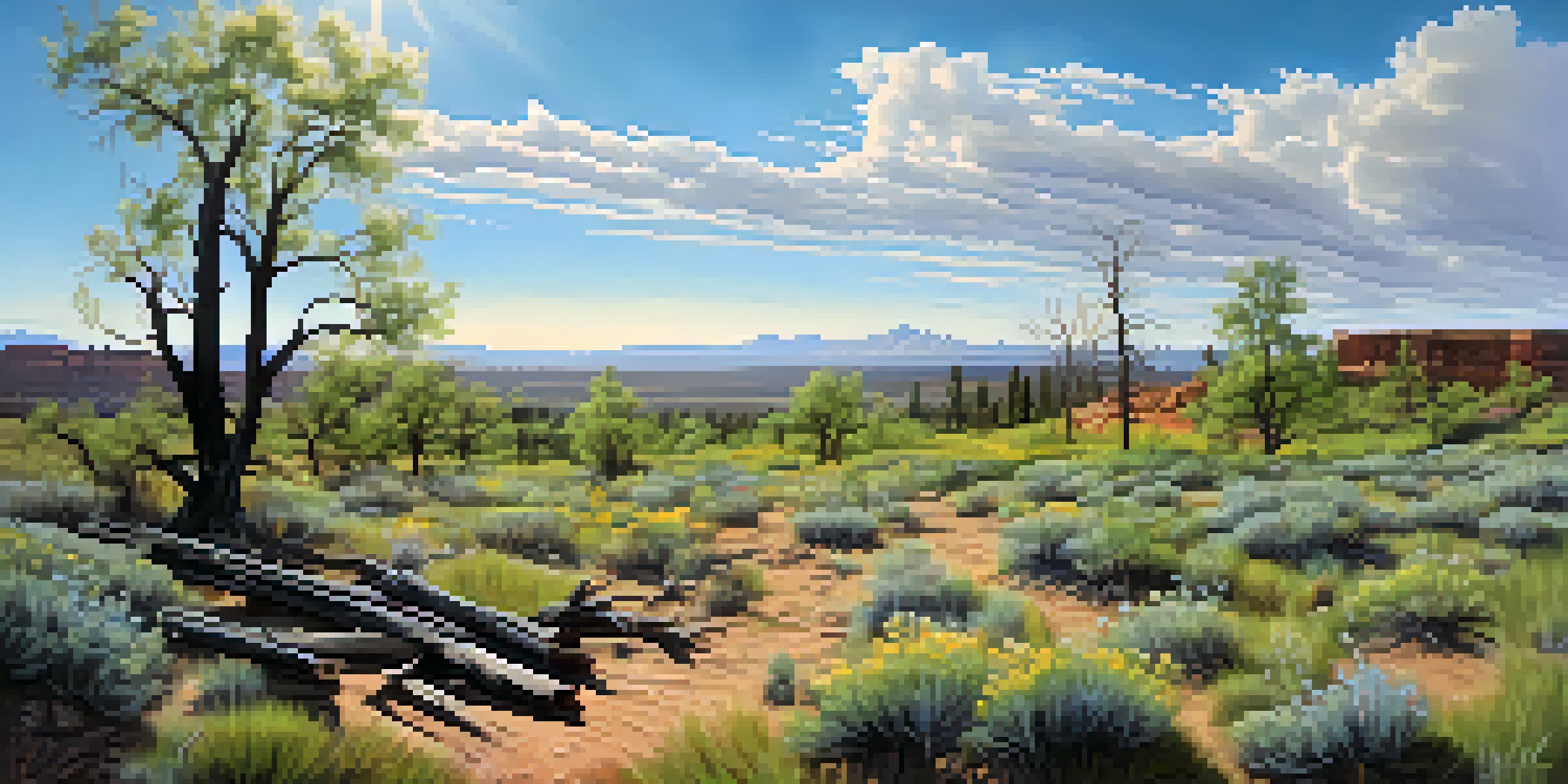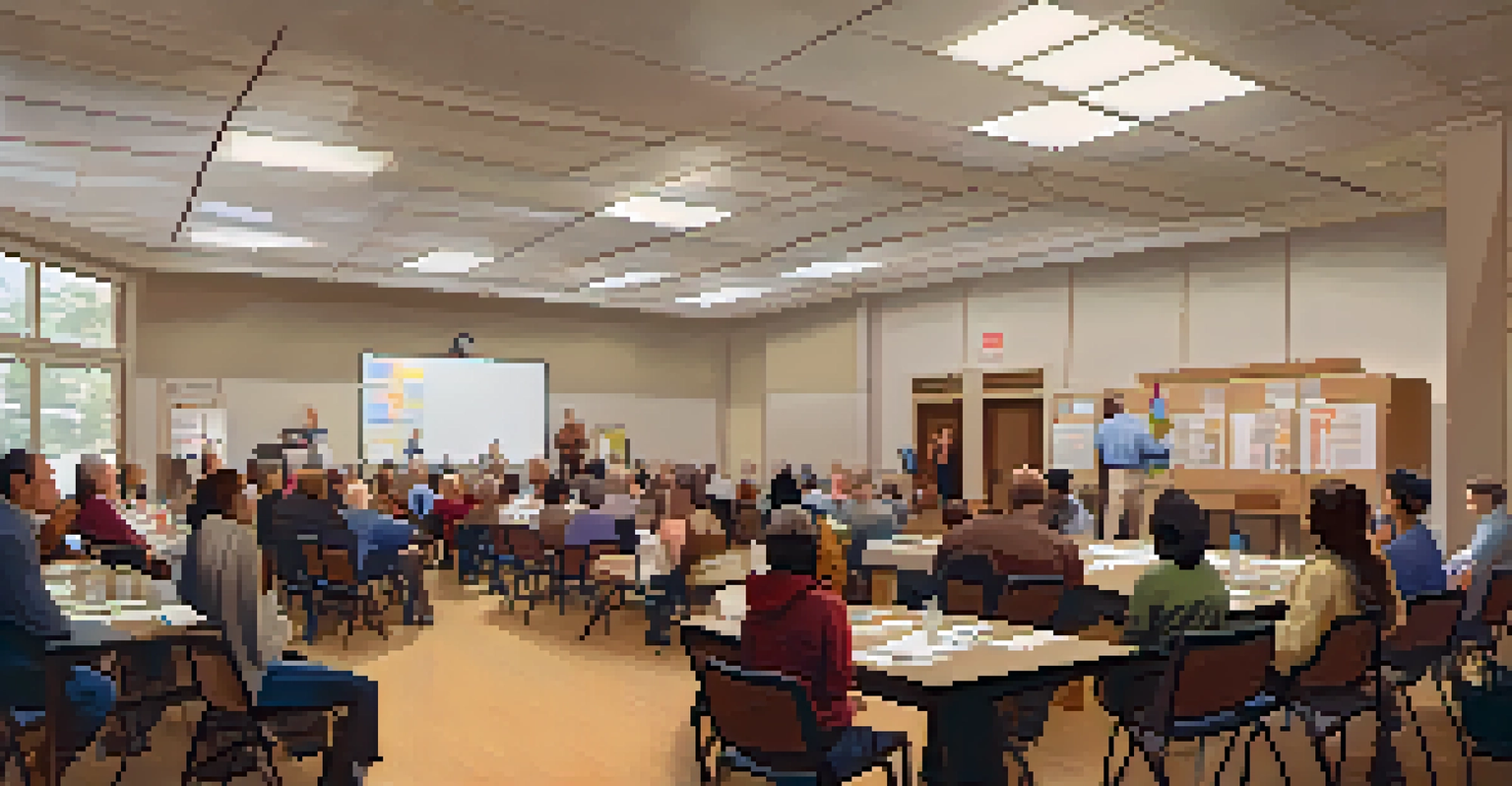Wildfires and Utah's Climate: Causes and Consequences

Understanding Wildfires: Nature's Double-Edged Sword
Wildfires are a natural part of many ecosystems, including Utah's. They can rejuvenate the land by clearing out dead vegetation and making way for new growth. However, while wildfires can benefit nature, they also pose significant risks to human life and property.
Wildfires are a natural part of the ecosystem; they can both destroy and rejuvenate.
In Utah, wildfires often arise during the hot, dry summer months, driven by a combination of natural and human factors. Lightning strikes can ignite fires, but human activities such as campfires, discarded cigarettes, and power lines are also common culprits. Understanding these causes is key to preventing future fires.
While some may view wildfires as merely destructive, they serve an essential ecological role. They help maintain the health of certain ecosystems, promoting biodiversity. Still, the balance between their benefits and risks needs careful management, especially as climate conditions change.
The Role of Climate Change in Utah's Wildfire Frequency
Climate change is a significant factor influencing the frequency and intensity of wildfires in Utah. Rising temperatures and prolonged drought conditions create an environment ripe for fires to ignite and spread. This shift can lead to more extreme fire seasons, impacting both nature and communities.

For instance, the summer of 2020 saw an exceptionally high number of wildfires in Utah, exacerbated by lower-than-average precipitation and higher than average temperatures. These conditions not only increase the likelihood of wildfires but also make them harder to control once they start. Understanding this connection between climate change and wildfires is crucial for future planning.
Wildfires: Nature’s Necessity and Threat
While wildfires are crucial for ecological health, they also pose significant risks to human life and property.
Moreover, the changes in climate can alter ecosystems, making them more susceptible to invasive species that thrive in fire-prone environments. This, in turn, can lead to a cycle where wildfires become more common, further intensifying the effects of climate change.
Human Impact: How Our Actions Influence Wildfires
Human activities play a significant role in the occurrence and intensity of wildfires. From recreational activities like camping to land management practices, our choices can either mitigate or exacerbate wildfire risks. Awareness of our impact is essential for fostering a culture of prevention.
The best way to prevent wildfires is to educate ourselves and take responsibility for our actions.
For example, many wildfires start due to careless behavior like leaving campfires unattended or improperly disposing of smoking materials. Simple steps, such as adhering to fire restrictions and using designated areas, can significantly reduce the risk of igniting a wildfire.
Additionally, land management practices, such as controlled burns and forest thinning, can help reduce the fuel that wildfires need to spread. By actively participating in these practices, communities can work together to minimize the threat of wildfires while preserving the health of their ecosystems.
The Economic Impact of Wildfires on Utah Communities
Wildfires have substantial economic consequences for Utah communities, affecting everything from property values to tourism. When wildfires rage through an area, they can lead to devastating losses for homeowners and businesses alike. Rebuilding can take years and drain local resources.
Moreover, the costs associated with firefighting efforts can be astronomical. States often allocate significant portions of their budgets to combat wildfires, diverting funds from other essential services. This financial strain can hinder community development and emergency preparedness efforts.
Climate Change Fuels More Wildfires
Rising temperatures and prolonged drought conditions due to climate change are increasing the frequency and intensity of wildfires in Utah.
On a more positive note, the aftermath of wildfires can also spur economic opportunities in restoration and rebuilding efforts. Communities often come together, fostering resilience and cooperation, which can ultimately lead to stronger, more united neighborhoods.
Environmental Consequences of Wildfires in Utah
Wildfires have profound environmental consequences, affecting air and water quality, soil health, and wildlife habitats. The immediate aftermath of a wildfire can be devastating, as the loss of vegetation leads to soil erosion and sediment runoff into water sources. This can impact local ecosystems and drinking water supplies.
Furthermore, wildfires release significant amounts of carbon dioxide and other pollutants into the atmosphere, contributing to air quality issues. In Utah, where air quality can already be a concern, the smoke from wildfires can exacerbate health problems for vulnerable populations.
However, it's essential to recognize that wildfires also play a role in ecosystem renewal. Over time, the land can recover, and new growth can occur, leading to a healthier environment. Balancing these short-term impacts with long-term ecological benefits is a complex but necessary conversation.
Community Preparedness: Strategies for Fire Season
Community preparedness is crucial in mitigating the impact of wildfires. Residents should be aware of their fire risk and take proactive measures to protect their homes and families. Simple actions, such as creating defensible space around properties and having emergency plans in place, can make a significant difference.
Local governments and organizations often provide resources and training for residents on wildfire preparedness. Engaging in community programs can help foster a sense of collective responsibility, ensuring that everyone is equipped to respond effectively in the event of a wildfire.
Community Preparedness is Essential
Proactive measures and community involvement are vital in mitigating the impacts of wildfires and ensuring safety during fire season.
Moreover, staying informed about fire conditions and following local guidelines during fire season can help communities stay safe. By working together, residents can create a culture of preparedness that not only protects individuals but also strengthens the entire community.
Future Outlook: Managing Wildfire Risks in Utah
Looking ahead, managing wildfire risks in Utah requires a multifaceted approach that includes proactive strategies, community involvement, and sustainable land management practices. As climate change continues to influence weather patterns, it's essential to adapt and prepare for an increasingly volatile environment.
Investing in research and technology can also play a crucial role in understanding and mitigating wildfire risks. Improved forecasting models and fire detection systems can help communities respond more effectively, saving lives and property.

Ultimately, a collaborative effort between government agencies, communities, and individuals will be key to navigating the challenges posed by wildfires in Utah. By embracing a proactive mindset, we can work towards a future where wildfires are managed more effectively, ensuring the safety and well-being of all.